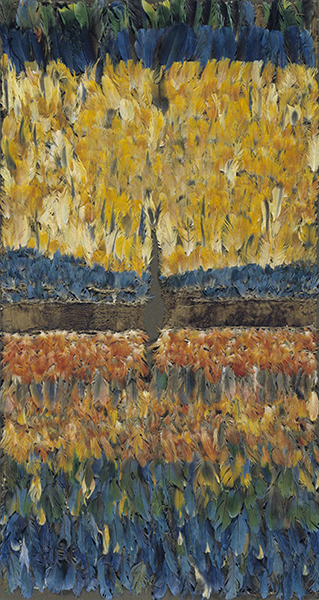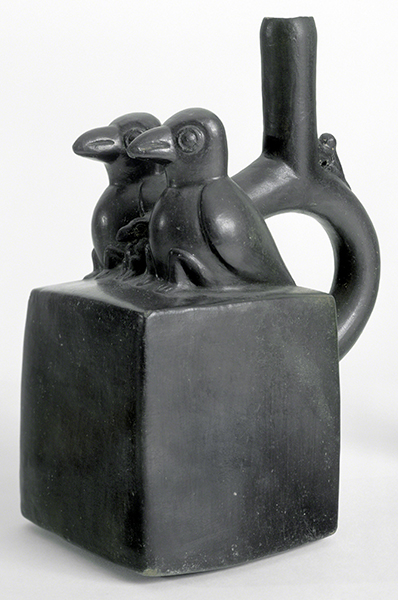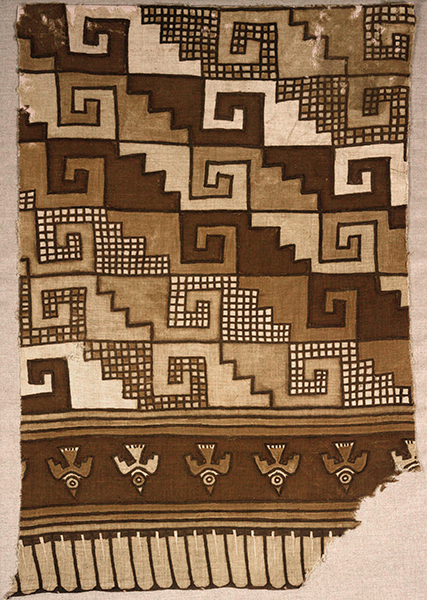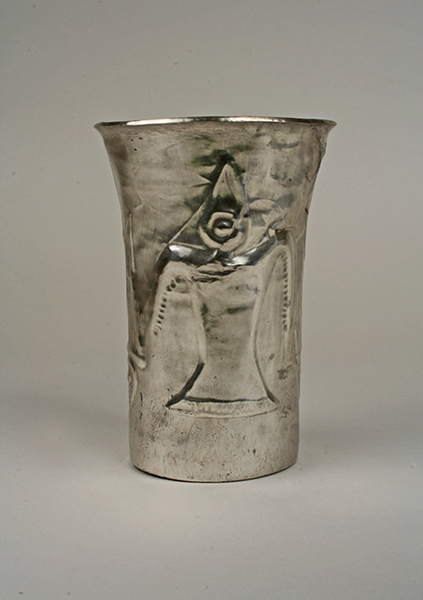Hispanic Heritage Month: Chimú of Peru
Like many Mesoamerican and South American cultures, ancient Peruvians developed large city-states with religious-secular rulers. The landscape in northern South America is very different from that of Mexico. It consists of a narrow coastal plain bordered by the Pacific Ocean in the west and the Andes Mountains in the east. The Andes are snow-capped peaks surrounding high grasslands and deep, fertile river valleys. The eastern side of the Andes descend into the lush basin of the Amazon River.
Andean people, in contrast to Mesoamerican peoples, developed monumental architecture and ceramic arts before textiles and agriculture. The earliest period of monumental building was ca. 3000 BCE with mound-like ceremonial centers built near the coast. The inland cultures built stone-walled cities with sunken, circular religious areas. Agriculture gradually became important to both societies. Among one of the most interesting artistically and culturally are the Chimú, whose culture flourished between about 900 and 1500 CE.
 |
| Chimú, Feathered Tabard (sleeveless jacket), ca. 1460–1528. Varied bird species feathers attached to tabby weave cotton, 38 9/16" x 20 7/8" (98 x 53 cm). © 2020 Cleveland Museum of Art. (CL-1095) |
The Chimú—a stylistic term used for the culture of the Chimor Kingdom—were the inheritors in power from the Wari (fell 700 CE) and Tiwanaku (fell 1000 CE) cultures. The Chimú in turn fell to the Inka (ca. 1470). The Chimú kingdom was a highly organized society centered in the walled city of Chan Chan (near contemporary Trujillo).
According to tradition, a hero called Taycanamo landed his fleet of balsa rafts on the shore of Peru in the year 900 CE and founded Chan Chan. Over the centuries, the population of Chan Chan grew to 50,000 inhabitants, as many as half of whom were artists. The artists worked in royal compounds surrounded by high adobe walls to control sand and dust.
Feather workers used a few coastal birds such as cormorants, egrets, ducks, and flamingos for their white, black, and pink feathers. However, the most popular feathers came from the rainforest. Macaws, parrots, parakeets, curassows, and tanagers provided the most vivid colors of yellow, green, blue, purple, and turquoise. In Chimú religion, sea birds such as pelicans were closely associated with the idea of human and agricultural fertility.
 |
| Chimú, Vessel with two sculpted birds, ca. 1350–1450. Black terra cotta, 9 1/8" x 4 ½" (23.2 x 11.4 cm). © 2020 Albright-Knox Art Gallery, Buffalo, NY. (AK-1112) |
Although the earlier Moche culture (ca. 200 BCE–ca. 500 CE) had the greatest artistic influence on Chimú arts, Chimú ceramics were not as sophisticated as the Moche or other Andean cultures. They almost uniformly were not painted and are characterized by sculptural forms with incised and raised decoration. Common raised designs include abstract humans, birds, or animals. The bird head with one prominent round eye surrounded by a circle was a common motif in all Chimú art forms. Unlike the more military Moche, birds were not associated with war or headhunting in Chimú iconography, but rather with prestige and abundance. They were also symbols of the afterlife. Chimú birds were not anthropomorphized but appear in naturalistic form on ceramics and undergo various degrees of geometricization on textiles, architectural friezes, and metalwork.
A major form of Chimú ceramics are called blackware. The dark color is not due to paint or slips but rather reduction firing. In that process, the amount of oxygen in the kiln is reduced. The fire finds oxygen in the elements in the clay body itself, which, in burning, alters the color of the clay from red to black.
Slab vessels such as this piece were mold-made. The mold was fired clay formed over an existing vessel. As the clay dried, it shrank from the mold and the various pieces were "glued" together with a mixture of clay and water. The seam was then smoothed.
Unlike the Moche culture, Chimú ceramics are not dominated by effigy vessels. Most Chimú wares represent elements of nature such as fruits, vegetables, and animals. The stirrup spout/handle is a standard form in Peruvian ceramics across all cultures.
 |
| Chimú, Textile fragment, ca. 1000–1470. Plain weave cotton, 35" x 23 ½" (88.9 x 59.7 cm). © 2020 Brooklyn Museum. (BMA-1271) |
Like all other Andean cultures, textiles of the Chimú were among the most sophisticated of their art forms. The Chimú were a textile-oriented culture, one in which weavings were sometimes used as money. Textiles played a significant role in the burial ceremony, in that the body of the deceased was always wrapped in some sort of weaving.
Chimú weavings such as this were produced usually by male weavers in alpaca wool and cotton. The alpaca is an animal of the sheep family, the wool of which is of high quality. Cotton was cultivated in Peru for textiles as far back as 3000 BCE. A plain weave fabric is also called a tabby weave. It consists of only a single warp (vertical element) and weft (horizontal element).
The step fret pattern combined with a hook shape is a common Chimú decorative design and is seen in artwork across Central and South America, not only in textiles but also architectural decoration (such as the Small Temple my post about Chichén Itzá). The round-eyed, geometricized bird pattern is an appropriate one for burial purposes.
Textiles survived in great quantities in burials because of the climate. The arid coastal plains of Peru receive very little rainfall, allowing for dry preservation of textiles. Textiles such as this were used to mark life stages, for ritual purposes, to indicate societal status, and to indicate region.
 |
| Chimú, Beaker with bird effigy, 1100s–1400s. Silver, height: 5 5/8" (14.3 cm). Metropolitan Museum of Art, New York, the Michael C. Rockefeller Memorial Collection, Gift of Nelson A. Rockefeller, 1969, 1978.412.177. |
Beakers (called kero or qero) were usually used for drinking corn beer. While only wooden beakers survive from the Inka, it is known from the Chimú and Sicán cultures that the highest status individuals drank from gold and silver vessels. These vessels were buried with the wealthy to represent that status in the afterlife. Again, the round-eyed bird appears as an appropriate motif for burial. Such beakers were made by hammering silver or gold over a wooden form and soldering the joints. Chimú elite also had silver versions of ceramic double spout and bridge vessels for burial purposes, made from sheets of silver that were molded over ceramic vessels.
Correlations to Davis programs: A Community Connection 2E: 1.5; A Global Pursuit 2E: 5.5; Discovering Art History 4E: 4.9; The Visual Experience 3E: 14.5


Comments